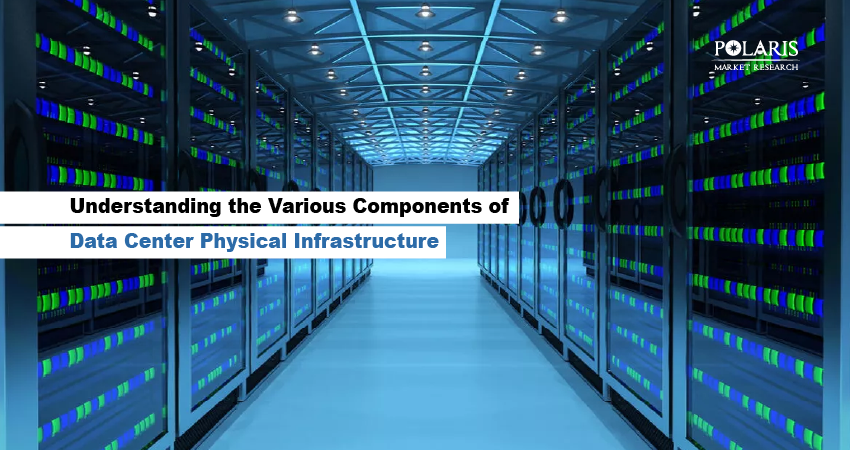Essential Components of Data Center Physical Infrastructure Explained

Data centers are an important part of the modern world. These physical computing resources allow businesses to operate their websites continuously. Data centers also make digital offerings possible. There are various components that make the operations of data centers possible.
In this blog post, we explain to you the essentials of data centers. We cover the different types of data centers and the components they use. The key stats for the data center physical infrastructure market and the impact of artificial intelligence (AI) on the market landscape have been covered. Stick with us!
What Is a Data Center?
A data center is a physical location that houses computing systems and their related hardware equipment. The computing infrastructure needed by IT systems is present in data centers. These include data storage drives, servers, and network equipment. The design of a data center is based on a network of storage and computing resources. These resources enable the delivery of data and shared applications.
What Are the Types of Data Centers?
Enterprise Data Centers
These data centers are also known as on-premises data centers. Specific organizations own and manage them. Enterprise data centers support the IT operations of companies. Complete control over infrastructure security is enabled by on-premise data centers. Also, they can be customized to meet the specific needs of an organization. Enterprise data centers typically have critical data and applications that need high privacy levels and regulatory compliance.
Cloud Data Centers
Cloud service providers own and manage these data centers. Computing resources are made available through the internet. Cloud data centers take away the need for organizations to manage physical hardware on-premises. Scalable virtual environments that store, process, and host applications is made available to companies. The access to computing resources is provided using subscription models. So, companies need to pay only for what they use.
Colocation Data Centers
These data centers provide shared facility space. Organizations can use the shared space for hosting their servers and hardware. Here, the colocation infrastructure isn’t owned by the company. Instead, space is rented by the organization within the facility. The shared nature of these data centers avoids a large capital outlay. One of the key benefits of colocation data centers is cost-effectiveness, as companies pay for only the space and resources they require.
Why Demand for Data Center Infrastructure Is Rising
Our newly published research study reveals that the data center physical infrastructure market is witnessing rapid growth. The market stood at USD 31.48 billion in 2024. It is projected to account for a CAGR of 15.00% from 2025 to 2034.
The growing adoption of cloud computing across sectors has created an increased need for data center physical infrastructure. Additionally, rising investments in smart cities by governments worldwide are boosting the data center physical infrastructure market expansion.
What Are Key Components of Data Center Infrastructure?
Servers and Compute Resources
Servers process and deliver data across networks. Servers intended for modern data centers need to be high-performing and reliable. They also need to be scalable to accommodate diverse workloads. Servers have advanced processors, storage, and memory capabilities. This allows them to handle complex computational tasks.
Storage Systems
Storage systems help save, retrieve, and manage large volumes of data. Storage systems may take the form of traditional hard drives or products from the solid-state drive market. Some data centers may go with object storage devices. Networked storage solutions such as network-attached storage (NAS) and storage area networks (SANs) may also be used. Efficient management of storage is needed to ensure optimal performance. Efficiently managing storage also ensures that data is available and reliable.
Networking Equipment
Networking equipment is highly important for data center communication. It enables connectivity between storage systems, servers, and external networks. Key networking components include switches, firewalls, and routers. These components make sure that the data transmission takes place in a secure manner. They also ensure that the network traffic flow is smooth and the connectivity is high-speed.
Power and Cooling Systems
Power and cooling systems help ensure that the operations of data centers are efficient and reliable. Power systems provide a consistent supply of power. Redundant power sources such as generators and uninterruptible power supplies (UPS) are often a part of power systems. Cooling systems are responsible for managing the heat generated by data centers. These systems from the data center liquid cooling market prevent the overheating of components and ensure that they deliver optimal performance.
Security Systems
Security systems cover both the physical and digital aspects of data centers. They ensure that data and infrastructure are protected. Surveillance systems and access controls are part of physical security. Digital security makes use of encryption and firewalls to protect systems against data breaches and cyberattacks. Security systems in data centers need to adhere to industry standards.
How AI is Changing the Data Center Physical Infrastructure Market?
Artificial intelligence (AI) is having a favorable impact on the data center physical infrastructure market. AI helps manage cooling and the distribution of power across data centers. This reduces the wastage of energy. Operational costs are also lowered. AI is capable of identifying network issues and hardware failures before they occur. This helps in reducing unexpected downtime. AI also has a role to play in improving the physical and cybersecurity of data centers. AI monitors access controls and detects potential anomalies.
Conclusion
Data centers have come a long way. They have witnessed significant evolution since the time of large mainframe computers. In the past, these systems were placed in climate-controlled environments for managing heat and ensuring reliability. Advances in technology and networking systems led to the introduction of distributed computing systems. This paved the path for client-server architectures and cloud data centers. Modern data centers house various advanced components that make operations flexible and scalable. Companies in the data center physical infrastructure market are focusing on the development of flexible designs that are capable of handling rising power densities.

